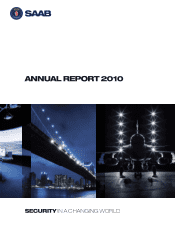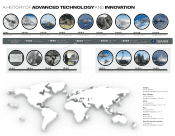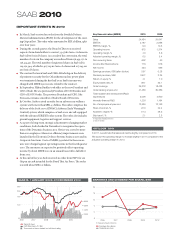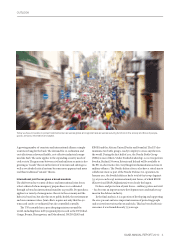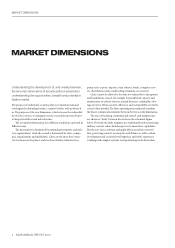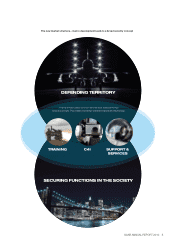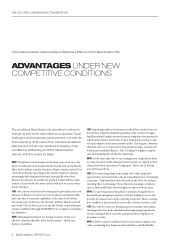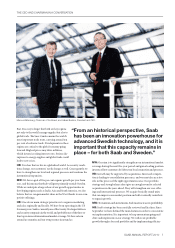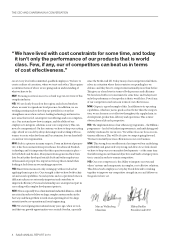Saab 2010 Annual Report Download - page 11
Download and view the complete annual report
Please find page 11 of the 2010 Saab annual report below. You can navigate through the pages in the report by either clicking on the pages listed below, or by using the keyword search tool below to find specific information within the annual report.
cies at every level with committed, qualied employees. We have to
create a culture of execution, where we trust each other. is requires
a common vision of where we are going and an understanding of
what we have to do.
MW: Focusing is critical, since it is so hard to get an overview of this
complex industry.
HB: We are clearly focused on the regions and selected markets
where we want to expand our local presence. In addition, we are
working continuously to develop our portfolio in a way that
strengthens areas where we have leading technology and invest in
new areas that we feel can improve our oerings and core competen-
cies. Our systems know-how is unique, and the ability of our
employees to integrate solutions is our core competency. is can
never be compromised. On the contrary, we have to keep our cutting
edge, which we can do by always listening to and working with cus-
tomers to create value for them and, by extension, for our sharehold-
ers and our own organisation.
MW: Saab is a pioneer in many respects. From an historical perspec-
tive, it has been an innovation powerhouse for advanced Swedish
technology, and it is important that this capacity remains in place –
for both Saab and Sweden. Many innovations generated here have
later been further developed outside Saab and today employ tens
of thousands of people. It is important to keep this in mind when
looking at Saab from an overarching perspective.
HB: Innovation means not only coming up with new ideas but
applying them in practice. Our strength is that we have both techni-
cal and social capabilities. Social systems and co-operation between
dierent cultures are extremely important and contribute to
improved eciency. Personal relationships are an important part in
succeed ing with complex development projects.
MW: is is especially true of international industrial alliances, which
are critical in order to deliver on large, complex systems orders in the
best way, and then get them to work on an operating level. To a large
extent it involves co-operation and social engineering.
HB: We started going international many years ago, when we real-
ized that our growth opportunities were outside Sweden, especially
since the Berlin wall fell. Today many of our competitors nd them-
selves in a situation where their countries are spending less on
defence, and they have to compete internationally more than before.
is gives us a head start in terms of both presence and eciency.
We have lived with cost constraints for some time, and today it isn’t
only the performance of our products that is world class. Few, if any,
of our competitors can beat us in terms of cost eectiveness.
MW: Gripen is a good example of this. In addition to its operating
capabilities, which are just as good as if not better than the competi-
tion, we are far more cost-eective throughout the supply chain: in
development, production, delivery and operations. is is more
obvious from a lifecycle perspective.
HB: e implementation of our eciency programme – the Billion+
programme – has led to further improvements, and underlying prof-
itability continued to rise in . We will not lose our focus on con-
tinuous eciency. is will be decisive to compete going forward.
We must constantly increase eciencies in our core business.
MW: is strong focus on eciencies has improved our underlying
protability and generated very strong cash ow. As we look ahead,
we have to keep our eye on market developments – at the same time
that delivering on our nancial objectives and Saab’s strategic priori-
ties is crucial in order to remain competitive.
HB: Our core competence is the ability to integrate our own and
others’ systems and components in complex, cost-eective solutions.
is drives Saab’s employees every day. I look forward to working
together to improve our competitive strength in and deliver on
the goals we have set.
Marcus Wallenberg Håkan Buskhe
Chairman President and CEO
“ We have lived with cost constraints for some time, and today
it isn’t only the performance of our products that is world
class. Few, if any, our of competitors can beat us in terms
of cost effectiveness.”
8 SAAB ANNUAL REPORT 2010
THE CEO AND CHAIRMAN IN A CONVERSATION

